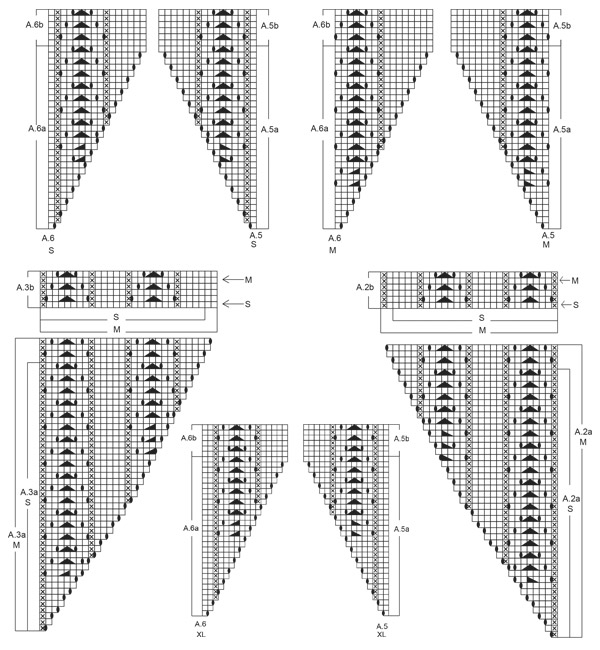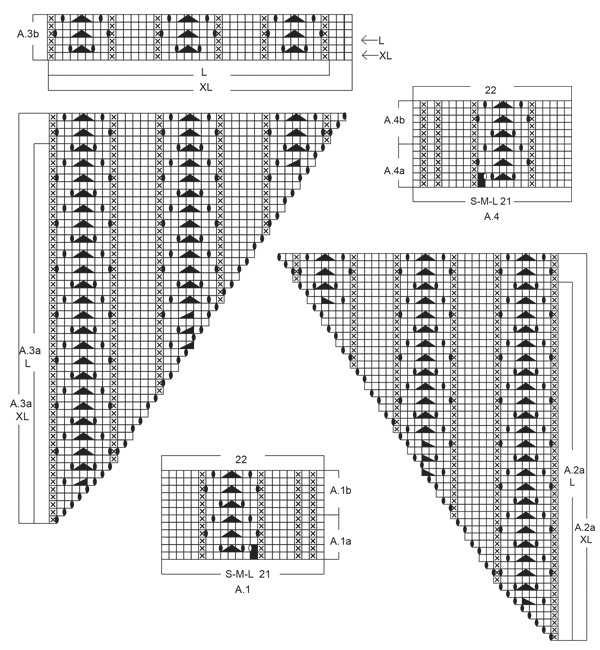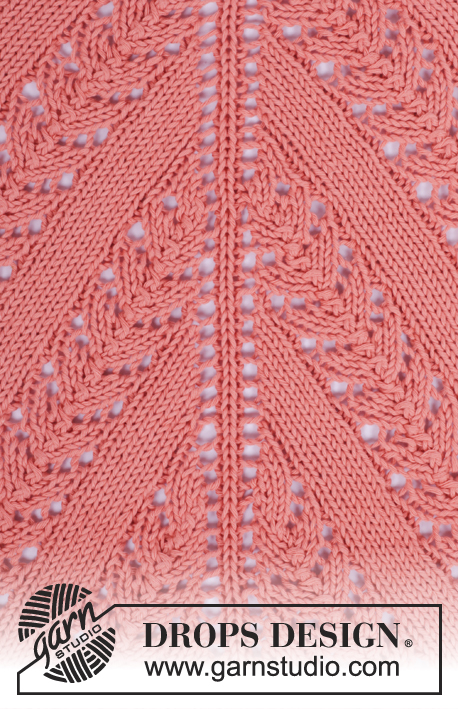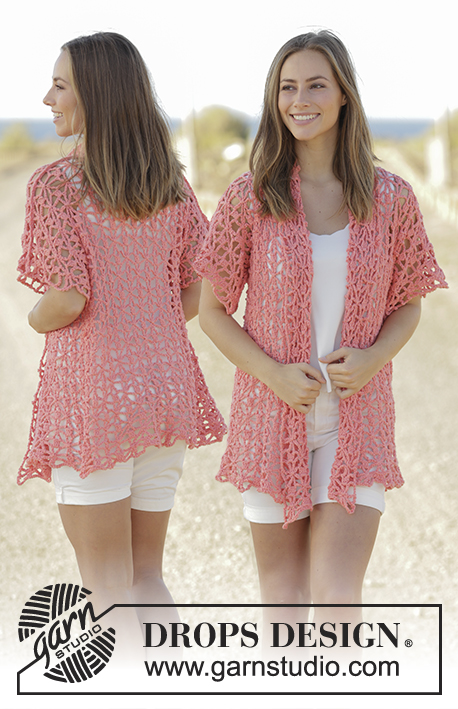Peach Ballet |
||||||||||||||||||||||||||||
|
|
||||||||||||||||||||||||||||
Knitted tunic with lace pattern, worked top down in DROPS Paris. Size: S - XXXL
DROPS 175-6 |
||||||||||||||||||||||||||||
|
GARTER STITCH (worked in the round): 1 ridge = 2 rounds. Knit 1 round and purl 1 round. GARTER STITCH (back and forth): K all rows. 1 ridge = K2 rows. RAGLAN: On sleeves increase for raglan with yarn over. Knit yarn overs twisted on next round to avoid holes. Increase as follows: Increase with 1 yarn over after 1st and 3rd marker and before 2nd and 4th marker as follows: Increase every round 0-2-4-0-0-0 times in total. Increase every other round 22-23-23-27-24-26 times in total. Increase every 4th round 0-0-0-0-2-2 times in total (= 22-25-27-27-26-28 times in total) = 48-54-60-60-62-66 stitches in total on each sleeve. PATTERN: See diagrams A.1 to A.8. Choose diagram for your size. DECREASE TIP-1: When working in the round, decrease as follows: Decrease as follows at each marker: Work until 3-3-3-5-6-6 stitches remain before marker, knit 2 together (= 1 stitch decreased), 2-2-2-6-8-8 stitches in garter stitch (marker is in the middle of these stitches), slip 1 stitch knitwise, knit 1, pass slipped stitch over (= 1 stitch decreased). When working back and forth, decrease as follows: All decreases are done from the right side. Work 3-3-3-3-4-4 stitches in garter stitch, slip 1 stitch knitwise, knit 1, pass slipped stitch over (= 1 stitch decreased), work pattern as before until 5-5-5-5-6-6 stitches remain, knit 2 together (= 1 stitch decreased), finish with 3-3-3-3-4-4 stitches in garter stitch. DECREASE TIP-2 (applies to sleeve): Decrease as follows at marker: Work until 3 stitches remain before marker, knit 2 together (= 1 stitch decreased), knit 2 (marker is in the middle of these stitches), slip 1 stitch knitwise, knit 1, pass slipped stitch over stitch worked (= 1 stitch decreased). BIND-OFF TIP: To avoid a tight bind-off edge you may use a needle ½-1 needle size larger. ---------------------------------------------------------- TUNIC: Worked in the round, top down. Cast on 80-84-86-92-96-102 stitches on circular needle size 4.5 mm / US 7 with Paris. Work 2 ridges in GARTER STITCH - see explanation above. Switch to circular needle SIZE 5.5 mm/US 9. Knit 1 round while AT THE SAME TIME increasing 22-18-20-22-26-28 stitches evenly = 102-102-106-114-122-130 stitches. On next round work pattern and increase for RAGLAN - see explanation above, as follows: Work A.1a over the first 21-21-21-23-23-25 stitches, A.2a over next stitch, purl 1, knit 1 (= mid back), purl 1, A.3a over next stitch, A.4a over the next 21-21-21-23-23-25 stitches (= back piece), insert 1st marker, knit 4-4-6-6-10-10, insert 2nd marker (= sleeve), A.1a over the next 21-21-21-23-23-25 stitches, A.2a over next stitch, purl 1, knit 1 (= mid front), purl 1, A.3a over next stitch, A.4a over the next 21-21-21-23-23-25 stitches (= front piece), insert 3rd marker, knit 4-4-6-6-10-10, insert 4th marker (= sleeve). Continue pattern like this. REMEMBER THE KNITTING GAUGE When A.1a and A.4a have been worked 1 time vertically, repeat A.1b and A.4b vertically. When A.2a and A.3a have been worked 1 time vertically, there are 298-318-362-378-402-430 stitches on needle. Piece measures approx. 22-24-25-27-28-30 cm / 8¾"-9½"-9¾"-10½"-11"-11¾" on the shortest. Work next round as follows: Continue with A.1b over the first 22-22-22-24-24-26 stitches as before, A.2b over the next 27-29-37-39-44-47 stitches, 1 yarn over, purl 1, knit 1 (= mid back), purl 1, 1 yarn over, A.3b over the next 27-29-37-39-44-47 stitches, A.4b over the next 22-22-22-24-24-26 stitches, slip the next 48-54-60-60-62-66 stitches on a stitch holder for sleeve, cast on 6-6-6-10-12-12 stitches under sleeve, insert 1 marker in the middle of the new stitches (= side marker), A.1b over the next 22-22-22-24-24-26 stitches as before, A.2b over the next 27-29-37-39-44-47 stitches, 1 yarn over, purl 1, knit 1 (= mid front), purl 1, 1 yarn over, A.3b over the next 27-29-37-39-44-47 stitches, A.4b over the next 22-22-22-24-24-26 stitches, slip the next 48-54-60-60-62-66 stitches on a stitch holder for sleeve, cast on 6-6-6-10-12-12 stitches under sleeve, insert 1 marker in the middle of the new stitches (= side marker) = 218-226-258-282-306-326 stitches. Work 1 round pattern, knit yarn over mid front and mid back, they should make holes. Work next round as follows: Continue with * A.1b over the first 22-22-22-24-24-26 stitches as before, A.2b over the next 27-29-37-39-44-47 stitches, A.5a over next stitch (increase 1 stitch in A.5a), purl 1, knit 1 (= mid back/front), purl 1, A.6a over next stitch (increase 1 stitch in A.6a), A.3b over the next 27-29-37-39-44-47 stitches, A.4b over the next 22-22-22-24-24-26 stitches as before, knit 2 together (= 1 stitch decreased), 2-2-2-6-8-8 stitches in garter stitch, slip 1 stitch knitwise, knit 1, pass slipped stitch over (= 1 stitch decreased) *, repeat from *-* 2 times in total. On this round increase 2 stitches mid front and mid back and decrease 2 stitches in each side of piece, i.e. number of stitches is the same. Insert 1 marker thread in piece, NOW MEASURE PIECE FROM HERE. Continue in the round as follows: ROUND/ROW 1: Work 1 round/row with pattern as before (= 1 round/row without yarn over in diagram). ROUND/ROW 2: Work pattern as before and decrease 1 stitch on each side of each side marker – READ DECREASE TIP-1. On this round/row increase 2 stitches mid front and mid back and decrease 2 stitches in each side of piece, i.e. number of stitches is the same. ROUND/ROW 3: Work as 1st round/row. ROUND/ROW 4: Work as 2nd round/row. ROUND/ROW 5: Work as 1st round/row. ROUND/ROW 6: Work as 2nd round/row. ROUND/ROW 7: Work as 1st round/row. ROUND/ROW 8: Work pattern as before. On this round/row increase 2 stitches mid front and mid back = 4 stitches increased in total. Do not decrease before and after side markers. Repeat 1st to 8th round/row until finished measurements. When A.5a and A.6a have been worked 1 time vertically, work A.5b and A.6b vertically. Now work A.7 after A.5b and A.8 before A.6a mid front and mid back until finished measurements, i.e. work increased stitches mid front/back in stockinette stitch. When piece measures 18 cm / 7" from marker thread under sleeve, adjust so that last round is 1 round with yarn overs, divide piece at side markers, work front piece and back piece separately until finished measurements. FRONT PIECE: (Begin at left side marker. First row = from wrong side). Work pattern and repeat 1st to 8th round/row as before, but work the outermost 3-3-3-3-4-4 stitches in each side of piece in GARTER STITCH – see explanation above. When piece measures 30 cm / 11¾" from marker thread under sleeve, switch to circular needle size 4.5 mm / US 7. Work 2 ridges over all stitches. Bind off - READ BIND-OFF TIP. BACK PIECE: Work as front piece. SLEEVE: = 48-54-60-60-62-66 stitches. Work sleeve in the round in stockinette stitch on double pointed needles. Slip stitches from stitch holder back on double pointed needles SIZE 5.5 mm/US 9 / US 9 and cast on 6-6-6-10-12-12 stitches under sleeve = 54-60-66-70-74-78 stitches. Work in stockinette stitch in the round and insert a marker in the middle of the new stitches under sleeve (i.e. 3-3-3-5-6-6 new stitches on each side of marker). NOW MEASURE PIECE FROM HERE! When piece measures 4 cm / 1½", decrease 1 stitch on each side of marker - READ DECREASE TIP-2. Decrease like this approx. every 3½-2½-2-2-2-1½ cm / 1¼"-⅞"-¾"-¾"-¾"-½" 9-12-14-15-16-17 times in total = 36-36-38-40-42-44 stitches. When sleeve measures 43-42-42-41-41-40 cm / 17"-16½"-16½"-16"-16"-15¾" (NOTE: Shorter measurements in the larger sizes because of longer yoke) switch to double pointed needles size 4.5 mm / US 7. Work 2 ridges. Bind off. Work the other sleeve the same way. ASSEMBLY: Sew the opening under the sleeve. |
||||||||||||||||||||||||||||
Diagram explanations |
||||||||||||||||||||||||||||
|
||||||||||||||||||||||||||||

|
||||||||||||||||||||||||||||

|
||||||||||||||||||||||||||||

|
||||||||||||||||||||||||||||

|
||||||||||||||||||||||||||||

|
||||||||||||||||||||||||||||
|
Have you made this or any other of our designs? Tag your pictures in social media with #dropsdesign so we can see them! Do you need help with this pattern?You'll find tutorial videos, a Comments/Questions area and more by visiting the pattern on garnstudio.com. © 1982-2024 DROPS Design A/S. We reserve all rights. This document, including all its sub-sections, has copyrights. Read more about what you can do with our patterns at the bottom of each pattern on our site. |
||||||||||||||||||||||||||||












































































Comments / Questions (13)
Bonjour. Je n arrive pas à avoir le bon échantillon. Avec les aiguilles indiquees j ai un demi centimetre de moins. Avec des aiguilles 6 j ai un demi centimetre de plus. Quelles aiguilles choisir pour etre la plus precise possible pourla taille XL? Merci
12.04.2022 - 16:46DROPS Design answered:
Bonjour Christiane, essayez de bloquer votre échantillon (avec les aiguilles 5,5) pour voir si la hauteur s'en trouve ajustée - un blocage (ou même un simple lavage/séchage) aide à donner un air plus régulier aux mailles et peut vous permettre d'obtenir la bonne hauteur (tout en conservant la bonne largeur). Bon tricot!
19.04.2022 - 08:51Mam pytanie może trochę dziwne czy w schematach są pokazane rzędy parzyste i nieparzyste Z góry dziękuje za odpowiedz
18.05.2021 - 21:13DROPS Design answered:
Witaj Kasiu, pytaj zawsze kiedy musisz, nie ma dziwnych pytań :) Schemat przedstawia wszystkie rzędy (parzyste i nieparzyste), widok jest taki jak na prawej stronie robótki. Szczegółowo ten temat jest opisany w kursie TUTAJ. Pozdrawiamy!
19.05.2021 - 18:09Jeg har problemer med antallet af masker i diagrammetA1a. Jeg vil strikke str xxl. Af diagrammet fremgår det, at der er 23 masker . Af teksten fremgår det, at jeg skal strikke diagrammet over 25 masker. Hvordan gør jeg? Hvis det er over 25 går det op med omgangens samlede antal masker, men hvordan får jeg det til at passe med diagrammet?
27.01.2021 - 00:21DROPS Design answered:
Hei Majbritt. Du strikker A.1a over 23 masker og så strikker du 2 masker av begynnelsen av A.1a = 25 masker av A.1a. God Fornøyelse!
01.02.2021 - 11:09Det er nødt til å være feil i forklaringen på økning med raglan. Det står at det skal økes etter merke 1 og 3 og før 2 og 4. Da blir det jo bare 4 masker til erme.....
29.05.2020 - 14:25DROPS Design answered:
Hei Marita. Nei, det er ikke feil. Det økes også i diagrammene på for- og bakstykket, se diagrammene. God Fornøyelse!
03.06.2020 - 10:46Bonjour quand vous dites TOUR/RANG 1 : Tricoter 1 tour/rang comme avant (=1 tour/rang sans les jetés dans les diagrammes) cela veut dire ne pas faire de jetés dans tous les diagrammes du rang ou seulement dans les diagrammes A.5a et A.6a. merci
23.06.2017 - 23:44DROPS Design answered:
Bonjour Stef, seulement dans A.5a et A.6a pour conserver le point fantaisie ajouré. Bon tricot!
26.06.2017 - 09:25Liebes Drops-Team, vielen Dank für dieses wunderschöne Strickmuster! Ich habe eine Frage zum Aufnehmen ganz am Anfang nach den 2 Krausrippen: Welche Technik sollte ich hierfür verwenden. Bei den Videos ist nur Aufnehmen 5 mit Umschlag. Was hierfür nehme ich an ungeeignet ist. Vielen Dank und herzliche Grüße!
20.06.2017 - 17:06DROPS Design answered:
Liebe Lisa-Sophia, hier können Sie mit Ihrem Lieblingstechnick zunehmen. Viel Spaß beim stricken!
21.06.2017 - 10:01Jeg har problemer med moensteret. Det er blokken A1 og A4 i str XL. Det er den del af moensteret, hvor der skal laves huller. jeg har ikke masker nok til at lave moensteret. I anden pind fra neden strikker jeg i A1 r,v,r,v,r,v,4r,v,slå om,r,sla om,r loes af, r, den loese over retten,2 r sammen,sla om,og så skulle det være 2r men der er kun 1 maske tilbage inden den gennemgaende retmaske. Hvad goer jeg forkert? Hilsen Anne Marie
09.06.2017 - 11:47DROPS Design answered:
Hej Anne Marie, hvis du sætter en mærketråd på hver side af diagrammet, så du er sikker på at du har 23 masker til at strikke A.1 og A.4 og husk at du ikke skal strikke den rude som er helt sort, den tager du først ud til på 2.pind. God fornøjelse!
09.06.2017 - 15:43Bonjour, Comment avez-vous réussi à aller au delà des 2 premiers rangs du point fantaisie? Je suis coincée, je n'arrive pas à savoir quoi faire de mes jetés qui ont créer des mailles, ce qui fait que je n'ai pas du tout de même rendu dans la constitution des diagrammes, je suis sans arrêt décalée. Je désire faire cette tunique pour cet été. Merci d'avance. MINA
19.05.2017 - 15:23DROPS Design answered:
Voir réponse ci-dessous :)
19.05.2017 - 15:32Hej Hvor finder jeg mål på størrelsen i opskriften f.eks hvad er målene i omkreds på XL i opskriften Tunika med hulmønster, som jeg har fået mail på str går fra S til XXXL men jeg kan ikke finde cm mål på de forskellige størrelser. Vil jo hverken have den for lille eller foe stor. Hilsen Elizabeth
19.03.2017 - 12:48DROPS Design answered:
Hej Elizabeth. Se nederst paa opskriften, her finder du alle maal i cm per störrelse. Laes ogsaa her nogle tips hvordan du vaelger den rette störrelse
20.03.2017 - 13:22Beautiful, can't wait to make it
06.01.2017 - 18:37